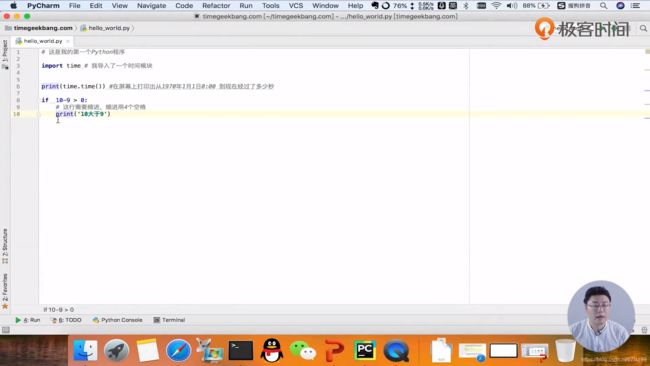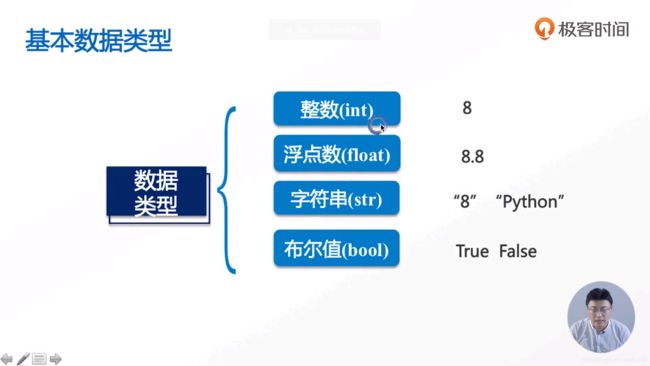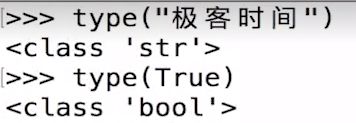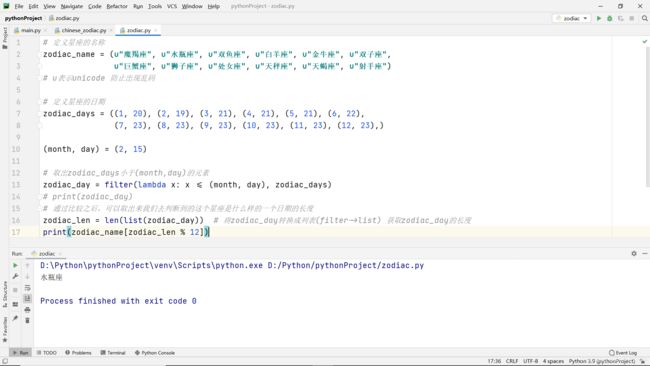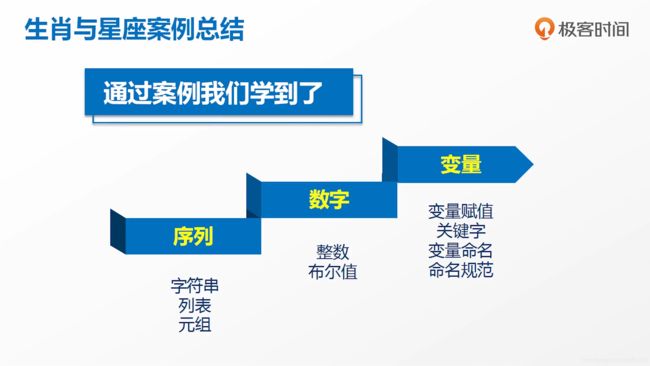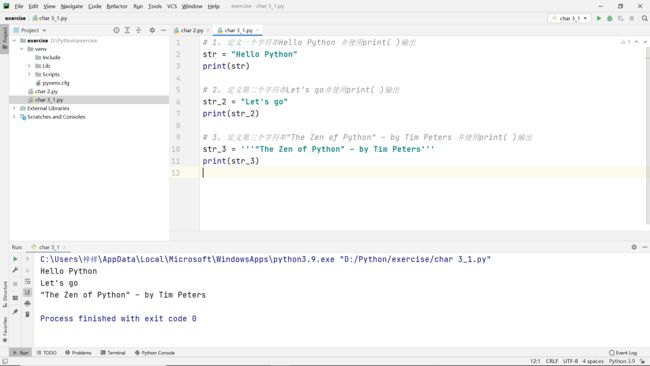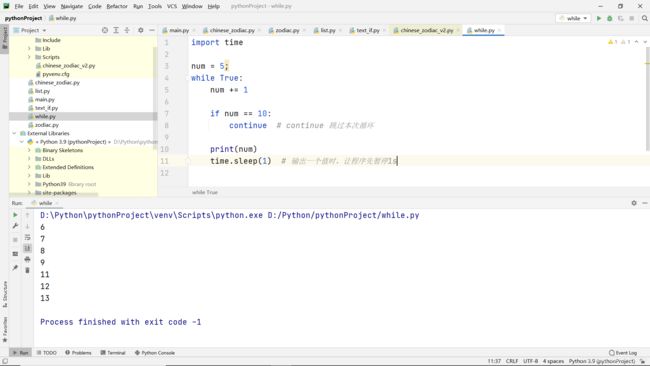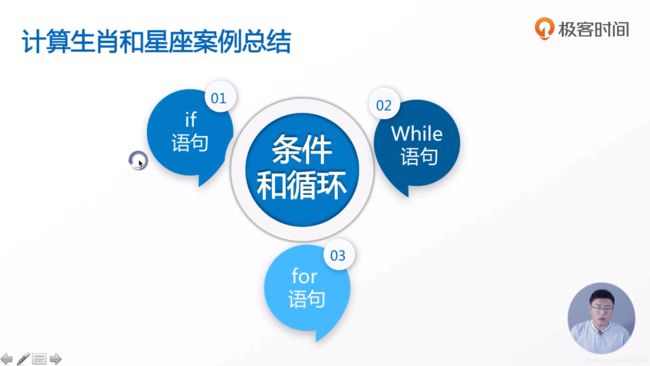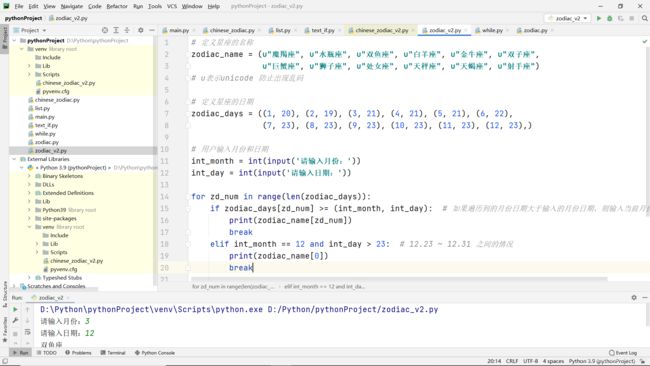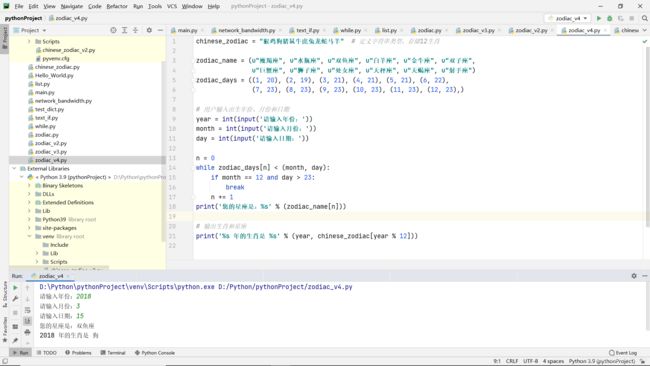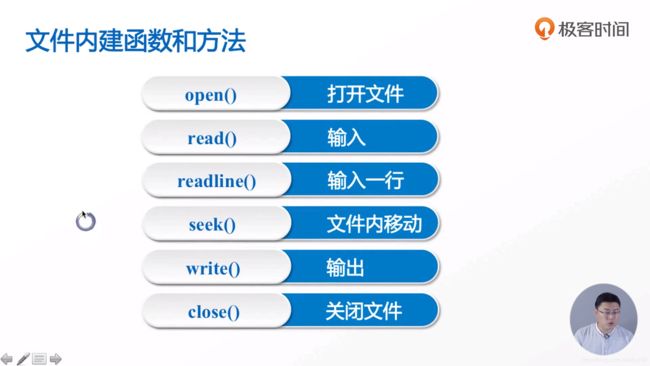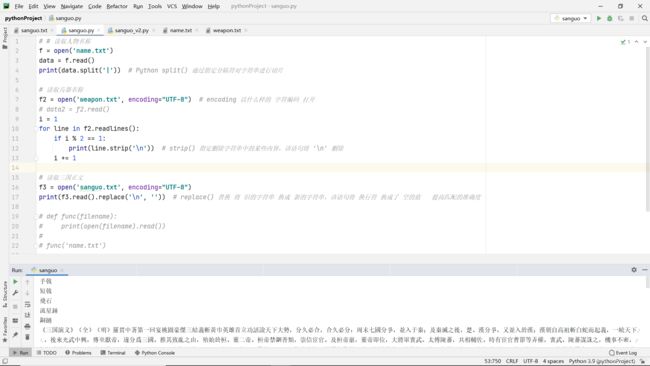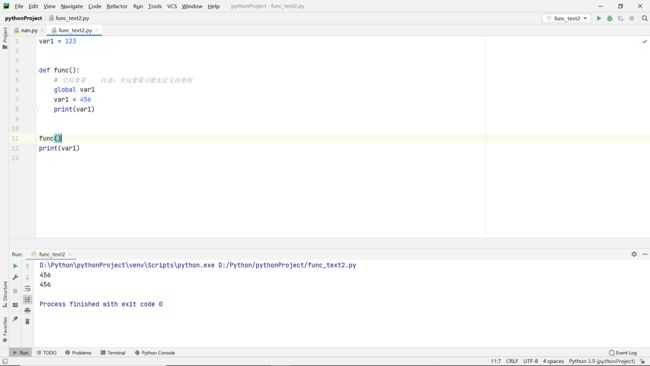《零基础学Python》——极客时间——学习笔记
第二章 Python基础语法
Python程序的书写规则
基础数据类型
类型判断
强制类型转换
变量的定义和常用操作
习题
题目:
练习一 变量的定义和使用
- 定义两个变量分别为美元和汇率
- 通过搜索引擎找到美元兑人民币汇率
- 使用Python计算100美元兑换的人民币数量并用print( )进行输出
第三章 序列
序列的概念
案例
概念
代码
字符串的定义和使用
字符串的常用操作
序列的基本操作
成员关系操作符
连接操作符
重复操作符
元组的定义和常用操作
元组中数字大小的比较
单个数字:

两个数字:
可当成是两个数字的叠加
![]()
120 < 220,故而结果为False。
列表和元组的区别
- 列表是中括号[],元组是小括号()
- 列表中的内容可变更,元组中的内容不可变更
fliter的功能
格式:
filter(lambda x: x < b, a)
取出a中小于b的元素
展示取出的元素
list(filter(lambda x: x < b, a))
例子:

统计取出元素的个数:
格式:
len (list (filter(lambda x: x < b, a)))
取出a中小于b的元素的个数
实现生肖查找功能
列表的定义和常用操作
基本操作:
- 增加一个元素
- 移除一个元素
习题
练习一 字符串
题目:
- 定义一个字符串Hello Python 并使用print( )输出
- 定义第二个字符串Let‘s go并使用print( )输出
- 定义第三个字符串"The Zen of Python" – by Tim Peters 并使用print( )输出
练习二 字符串基本操作
题目:
- 定义两个字符串分别为 xyz 、abc
- 对两个字符串进行连接
- 取出xyz字符串的第二个和第三个元素
- 对abc输出10次
- 判断a字符(串)在 xyz 和 abc 两个字符串中是否存在,并进行输出
练习三 列表的基本操作
- 定义一个含有5个数字的列表
- 为列表增加一个元素 100
- 使用remove()删除一个元素后观察列表的变化
- 使用切片操作分别取出列表的前三个元素,取出列表的最后一个元素
练习四 元组的基本操作
题目:
- 定义一个任意元组,对元组使用append() 查看错误信息
- 访问元组中的倒数第二个元素
- 定义一个新的元组,和 1. 的元组连接成一个新的元组
- 计算元组元素个数
第四章 条件与循环
条件语句
语法
代码
for循环
while循环
用法
通常和if条件判断语句连用
break语句
continue语句
总结
for语句中的if嵌套
while循环语句中的if嵌套
习题
练习一 条件语句的使用
题目:
- 使用if语句判断字符串的长度是否等于10,根据判断结果进行不同的输出
- 提示用户输入一个1-40之间的数字,使用if语句根据输入数字的大小进行判断,如果输入的数字在 1-10,11-20,21-30,31-40,分别进行不同的输出
练习二 循环语句的使用
题目:
- 使用for语句输出1-100之间的所有偶数
- 使用while语句输出1-100之间能够被3整除的数字
第五章:映射与字典
字典的定义和常用操作
定义和添加元素
生肖与星座案例完善
chinese_zodiac = "猴鸡狗猪鼠牛虎兔龙蛇马羊" # 定义字符串类型,存储12生肖
zodiac_name = (u"魔羯座", u"水瓶座", u"双鱼座", u"白羊座", u"金牛座", u"双子座",
u"巨蟹座", u"狮子座", u"处女座", u"天秤座", u"天蝎座", u"射手座")
zodiac_days = ((1, 20), (2, 19), (3, 21), (4, 21), (5, 21), (6, 22),
(7, 23), (8, 23), (9, 23), (10, 23), (11, 23), (12, 23),)
# 定义字典
cz_num = {
}
z_num = {
}
# 初始化关键字
for i in chinese_zodiac:
cz_num[i] = 0 # 将chinese_zodiac关键字依次赋值为0
for i in zodiac_name:
z_num[i] = 0 # 将zodiac_name关键字依次赋值为0
while True:
# 用户输入出生年份、月份和日期
year = int(input('请输入年份:'))
month = int(input('请输入月份:'))
day = int(input('请输入日期:'))
n = 0
while zodiac_days[n] < (month, day):
if month == 12 and day > 23:
break
n += 1
# 输出生肖和星座
print('您的星座是:%s' % (zodiac_name[n]))
print('%s 年的生肖是 %s' % (year, chinese_zodiac[year % 12]))
# 将值赋给初始化的字典
cz_num[chinese_zodiac[year % 12]] += 1 # 用户当前的生肖, 出现一次就加一,生肖的名字对应的值加一
z_num[zodiac_name[n]] += 1 # 用户当前的星座,出现一次就加一,星座的名字对应的值加一
# 输出生肖和星座的统计信息
for each_key in cz_num.keys(): # .keys() 取出字典中所有的key
print('生肖 %s 有 %d 个' % (each_key, cz_num[each_key]))
for each_key in z_num.keys():
print('星座 %s 有 %d 个' % (each_key, z_num[each_key]))
结果:
请输入年份:2018
请输入月份:1
请输入日期:3
您的星座是:魔羯座
2018 年的生肖是 狗
生肖 猴 有 0 个
生肖 鸡 有 0 个
生肖 狗 有 1 个
生肖 猪 有 0 个
生肖 鼠 有 0 个
生肖 牛 有 0 个
生肖 虎 有 0 个
生肖 兔 有 0 个
生肖 龙 有 0 个
生肖 蛇 有 0 个
生肖 马 有 0 个
生肖 羊 有 0 个
星座 魔羯座 有 1 个
星座 水瓶座 有 0 个
星座 双鱼座 有 0 个
星座 白羊座 有 0 个
星座 金牛座 有 0 个
星座 双子座 有 0 个
星座 巨蟹座 有 0 个
星座 狮子座 有 0 个
星座 处女座 有 0 个
星座 天秤座 有 0 个
星座 天蝎座 有 0 个
星座 射手座 有 0 个
请输入年份:2021
请输入月份:3
请输入日期:25
您的星座是:白羊座
2021 年的生肖是 牛
生肖 猴 有 0 个
生肖 鸡 有 0 个
生肖 狗 有 1 个
生肖 猪 有 0 个
生肖 鼠 有 0 个
生肖 牛 有 1 个
生肖 虎 有 0 个
生肖 兔 有 0 个
生肖 龙 有 0 个
生肖 蛇 有 0 个
生肖 马 有 0 个
生肖 羊 有 0 个
星座 魔羯座 有 1 个
星座 水瓶座 有 0 个
星座 双鱼座 有 0 个
星座 白羊座 有 1 个
星座 金牛座 有 0 个
星座 双子座 有 0 个
星座 巨蟹座 有 0 个
星座 狮子座 有 0 个
星座 处女座 有 0 个
星座 天秤座 有 0 个
星座 天蝎座 有 0 个
星座 射手座 有 0 个
请输入年份:
列表推导式与字典推导式
习题
练习一 字典的使用
题目:
- 定义一个字典,分别使用a、b、c、d作为字典的关键字,值为任意内容
- 为该字典增加一个元素‘c’:'cake’后,将字典输出到屏幕
- 取出字典中关键字为d的值
练习二 集合的使用
题目:
- 将字符串hello中每个字符赋值给一个集合,将这个集合输出到屏幕’
第六章 文件的输入输出
文件的内建函数
文件的常用操作
代码:
# # 将小说的主要人物记录在文件中
#
# # 写入文件 的 基本流程:open() -> write() -> close()
# file1 = open('name.txt', 'w') # 打开的文件名称为"name.txt",模式为"写入模式" 并将其赋值给一个变量
#
# file1.write(u'诸葛亮') # 写入人物
# file1.close() # 关闭并保存
#
# # 读取文件 的 基本流程:open() -> read() -> close()
# file2 = open('name.txt') # mode默认为“mode=r”——只读模式
# print(file2.read())
# file2.close()
#
# # 写入一个新人物
# file3 = open('name.txt', 'a')
# file3.write('刘备')
# file3.close()
# # 读取多行中的一行
# file4 = open('name.txt')
# print(file4.readline())
#
# # 读取每一行同时进行操作(以行的方式读取,逐行操作)
# file5 = open('name.txt')
# for line in file5.readlines(): # readlines 逐行读取
# print(line)
# print('=====')
# 进行一个操作,操作完成后回到文件的开头,然后再次对文件进行操作
file6 = open('name.txt')
file6.tell() # 告诉用户“文件指针”在哪
# 指针的功能:当没有进行人为操作时,程序会记录当前操作的位置,然后继续向后进行操作
print('当前文件指针的位置 %s' % file6.tell())
print('当前读取到了一个字符,字符的内容是 %s' % file6.read(1)) # 只读取文件的 1个字符
print('当前文件指针的位置 %s' % file6.tell())
# 需求:操作完成后,向回到文件的开头,再次进行操作
# 操纵指针
# 第一个参数:偏移位置(偏移量) 第二个参数:0——表示从文件开头偏移 1——表示从当前位置偏移 2——表示从文件结尾偏移
file6.seek(0) # file6.seek(5, 0) 从文件开头 向后偏移 5个位置
print('我们进行了seek操作')
print('当前文件指针的位置 %s' % file6.tell())
# 又一次读取一个字符
print('当前读取到了一个字符,字符的内容是 %s' % file6.read(1)) # 只读取文件的 1个字符
print('当前文件指针的位置 %s' % file6.tell())
file6.close()
结果:
当前文件指针的位置 0
当前读取到了一个字符,字符的内容是 a
当前文件指针的位置 1
我们进行了seek操作
当前文件指针的位置 0
当前读取到了一个字符,字符的内容是 a
当前文件指针的位置 1
练习一 文件的创建和使用
题目:
- 创建一个文件,并写入当前日期
- 再次打开这个文件,读取文件的前4个字符后退出
代码:
# 1. 创建一个文件,并写入当前日期
import datetime
now = datetime.datetime.now() # now变量 存储 现在的时间
new_file = open('date.txt', 'w')
new_file.write(str(now))
new_file.close()
# 2. 再次打开这个文件,读取文件的前4个字符后退出
again_file = open('date.txt')
print(again_file.read(4)) # 打印 读取的4个字符
print(again_file.tell()) # 文件指针,提示 读取了 4个字符
again_file.close()
结果:
2021
4
第七章 错误和异常
异常的检测和处理
常见错误
1. NameError
2. SyntaxError
3. IndexError
4. KeyError
5. ValueError
6. AttributeError
7. ZeroDivisionError
8. TypeError
捕获所有错误
except Exception
异常处理
except可捕获多个异常
捕获成功后显示额外错误信息
手动抛出异常
Python raise用法
finally
总结
习题
练习一 异常
题目:
- 在Python程序中,分别使用未定义变量、访问列表不存在的索引、访问字典不存在的关键字观察系统提示的错误信息
- 通过Python程序产生IndexError,并用try捕获异常处理
第八章 函数
函数的定义和常用操作
import re
def find_main_characters(character_name):
with open('sanguo.txt', encoding='UTF-8') as f:
data = f.read().replace("\n", "")
name_num = re.findall(character_name,data)
return character_name, len(name_num)
name_dict = {
}
with open('name.txt') as f:
for line in f:
names = line.split('|')
for n in names:
char_name, char_number = find_main_characters(n)
name_dict[char_name] = char_number
weapon_dict = {
}
with open('weapon.txt', encoding="UTF-8") as f: # 默认按行读取
i = 1
for line in f:
if i % 2 == 1:
weapon_name, weapon_number = find_main_characters(line.strip('\n')) # 读取 删除'\n'的 该行内容
weapon_dict[weapon_name] = weapon_number
i = i + 1
name_sorted = sorted(name_dict.items(), key=lambda item: item[1], reverse=True)
print(name_sorted[0:10])
weapon_sorted = sorted(weapon_dict.items(), key=lambda item: item[1], reverse=True)
print(weapon_sorted[0:10])
结果:
![]()
函数的可变长参数
关键字参数
作用:
当没有按顺序写入参数时调用。
优点:
- 可以不用按顺序写入参数
- 更明确输入的参数究竟是什么含义
可变长参数
函数的变量作用域
全局变量
函数的迭代器与生成器
迭代器
功能
取列表当中每一个元素,对每一个元素依次进行处理,这种方法叫做迭代,能实现这种方法的函数,叫迭代器
两种函数(方法)
生成器
定义
自己制作的迭代器叫生成器。
带yield的迭代器
自定义的迭代器
代码1:
for i in range(10, 20, 0.5):
print(i)
会报错,range()函数不允许令float数作为其步长。
代码2:
# 实现一个支持小数步长增长的range
def frange(start, stop, step):
x = start
while x < stop:
yield x # yield 运行到yield时会进行暂停,并记录当前的位置,当再次调用next()时,它会通过当前位置再去返回一个值
x += step
for i in frange(10, 20, 0.5):
print(i)
结果:
10
10.5
11.0
11.5
12.0
12.5
13.0
13.5
14.0
14.5
15.0
15.5
16.0
16.5
17.0
17.5
18.0
18.5
19.0
19.5
Lambda表达式
作用
简化函数。
代码:
def true():
return True
# 等于
def true():return True
# 等于
lambda: True
def add(x, y):
return x + y
# 等于
def add(x, y):return x + y
# 等于
lambda x, y:x + y # 参数是 x,y 返回是 x+y
lambda返回的是lambda的表达式:
用途
代码1:
lambda x: x <= (month, day) # 参数是:x,返回的是:x <= (month, day)
# 转换成函数
def find(x):
return x <= (month, day)
代码2:
lambda item: item[1] # 参数是:item,返回的是:item[1]
# 转换成函数
def find2(item): # 传入一个字典元素,取字典的值
return item[1]
adict = {
'a': '123', 'b': '456'}
for i in adict.items():
print(find2(i)) # 取字典的值
Python 字典(Dictionary) items() 函数的用法。
Python内建函数
filter
功能:
filter(function, sequence)
过滤 sequence 中满足funciton的数
代码:
a = [1, 2, 3, 4, 5, 6, 7]
b = list(filter(lambda x: x > 2, a)) # 过滤 a 中 满足 大于2的数
print(b)
结果:
[3, 4, 5, 6, 7]
必须转化成list,否则lambda不会被执行
map
功能:
map(function, sequence)
对sequence中的值依次按function处理
代码1:
c = [1, 2, 3]
map(lambda x: x, c) # 将 c 中的值 依次 返回 x
d = list(map(lambda x: x, c))
print(d)
map(lambda x: x + 1, c) # 将 c 中的值 依次+1 返回
e = list(map(lambda x: x + 1, c))
print(e)
结果:
[1, 2, 3]
[2, 3, 4]
代码2:
a = [1, 2, 3]
b = [4, 5, 6]
map(lambda x, y: x + y, a, b)
c = list(map(lambda x, y: x + y, a, b))
print(c)
结果:
[5, 7, 9]
对应项依次相加输出。
reduce
功能:
reduce(function, sequence[, initial])
把序列的元素依次和初始值按照函数的方式做运算。
代码:
from functools import reduce
total = reduce(lambda x, y: x + y, [2, 3, 4], 1) # 1 和 列表中第一个元素 按照 func 进行操作
print(total)
# ((1+2)+3)+4
结果:
10
zip
功能一:纵向整合
代码:
exchange = zip((1, 2, 3), (4, 5, 6))
for i in exchange:
print(i)
# 进行了纵向整合,类比线性代数中的“矩阵转换”
结果:
(1, 4)
(2, 5)
(3, 6)
(1, 2, 3)
(4, 5, 6)
(1, 4)
(2, 5)
(3, 6)
功能二:字典中 key 和 value 对调
代码:
dicta = {
'a': '123', 'b': '456'}
dictb = zip(dicta.values(), dicta.keys())
# ('a', 'b'), ('1', '2') --> ('a', '1'), ('b', '2')
print(dictb)
print(dict(dictb)) # 需将其类型强制转换为 dict
结果:
<zip object at 0x0000016A531F7E40>
{
'123': 'a', '456': 'b'}
闭包的定义
闭包
定义:
外部函数中的变量被内部函数引用,就叫做 “闭包”
代码:
def func